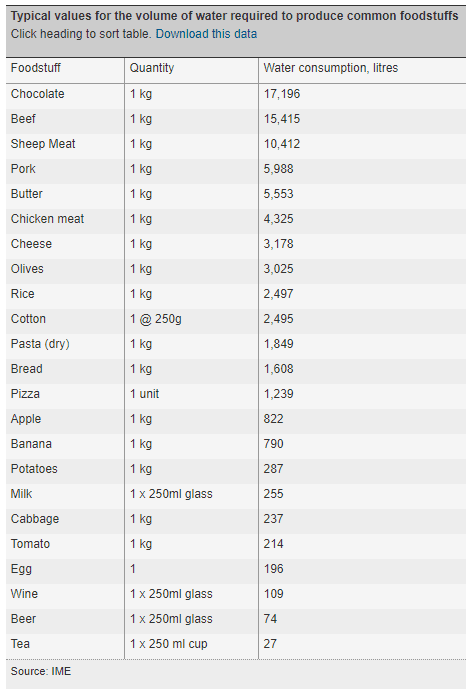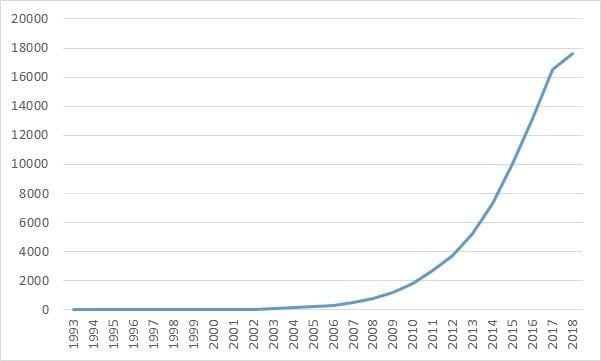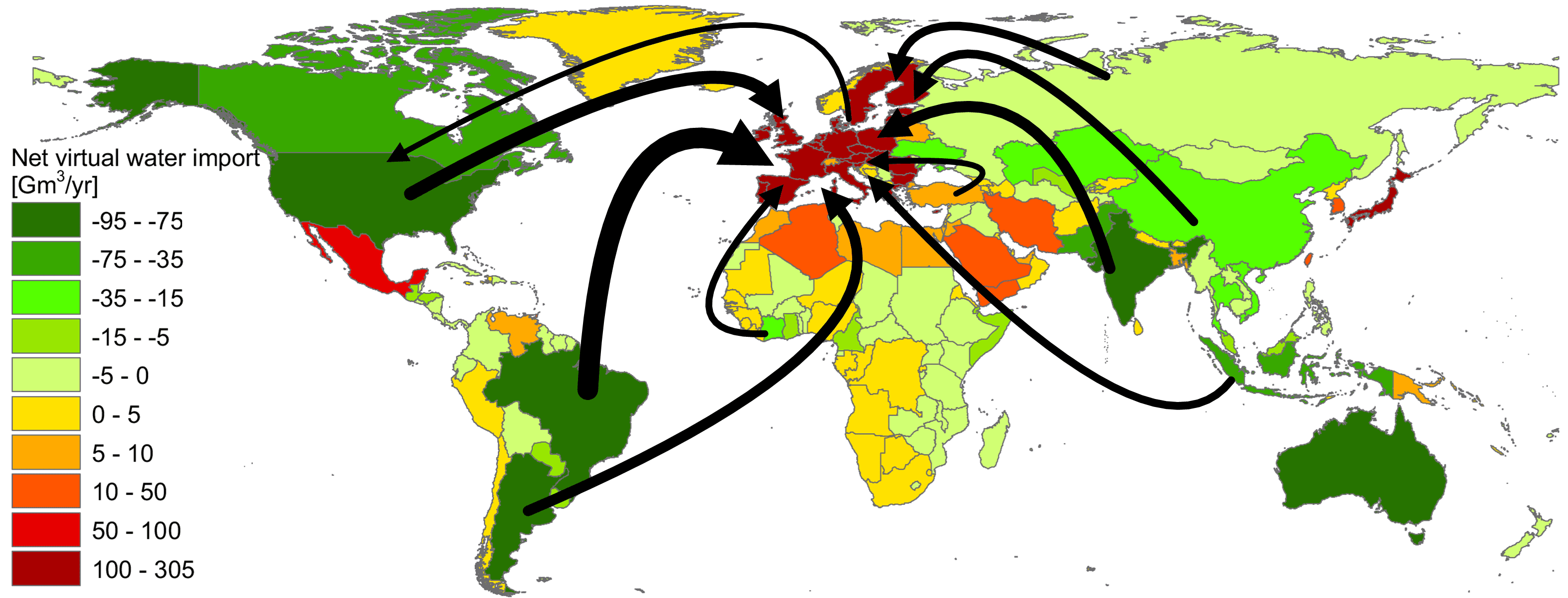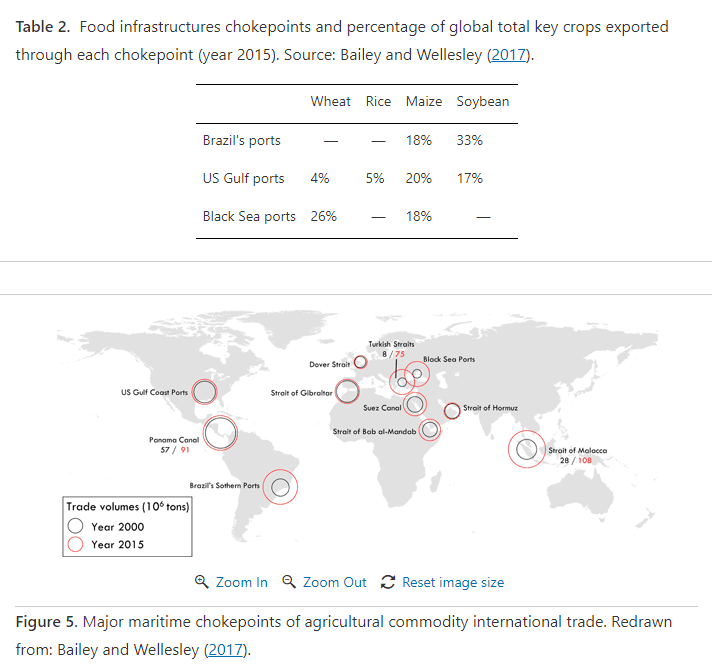Virtual Water Trade: Complete Guide on What it is and its impact
Water is a scarce commodity. It is not just needed for drinking purposes, but most importantly for agriculture. If you lose water or don’t have freshwater resources, you cannot have any crops. There is a trade going on – often unbeknownst to many countries which are the victims of these surreptitious flows – where some water surplus countries do not use their own water but use the land and water under it from another, often poor and even water-scarce countries and societies, to outsource their agricultural produce and import it. With that produce comes the water. Virtual water trade. We have discussed this concept briefly in our post on how Saudi Arabia handles its water crisis.
Water Footprint and Virtual Water Trade
What is it? Virtual Water Trade refers to the volumes of water that are embedded (or used) in the flow of exports and imports of products to and from a country or region. For example, 1 kg of wheat requires 1350 liters of water. That is the Water footprint of wheat. The Water footprint of different food commodities underlies the virtual water trade that is going on when those food products are imported or exported.
Virtual water is embedded in agricultural, forestry, industrial, and mining products
The water footprint can be further divided into Green Water footprint, Blue Water footprint and Grey Water footprint.
different water footprints
Green water footprint is the fraction of the WF that is contributed by green water (i.e. precipitation water directly contributing to the soil water balance in the crops’ root zone in the absence of irrigation).
Blue water footprint is the fraction of the WF that is contributed by the consumptive use of blue water (i.e. irrigation water withdrawn from surface water bodies and aquifers).
Grey water footprint is an indicator of freshwater pollution defined as the water volume required to dilute pollutants to a concentration that meets the water quality standards.
Just as an aside – every year a whopping 2 bn tonnes of food is wasted globally. That is half of all food produced globally every year! This was mentioned in a report published by the Institution of Mechanical Engineers (IME).
Here is a table that shows the water footprint of different foods.

Who coined “Virtual Water” as a concept?
John Anthony Allan a British geographer (emeritus professor at King’s College London) had invented the concept of “Virtual Water” in 1993.
How then is it possible to argue that there are substitutes for water? The answer is partly that they have already been found … [Many countries] either have sufficient water or they do not need it since they can substitute oil revenues to purchase food which cannot be produced at home because of water shortages.
He called water as liquid capital.
It took over a decade for this concept to be fully appreciated by experts. In March 2008, Allan was given the Stockholm Water Prize by the Stockholm International Water Institute. It was for bringing the concept of virtual water to the fore and bringing out the close relationships between crop production, economics, and political processes. You can see how it wasn’t until the latter part of the first decade of the 2000s that “virtual water” was being cited.

How the virtual water trade works
Many Northern European countries import water in virtual form by importing agricultural and other food products. They have a net import, which helps them save water in their own countries – not necessarily scarce – while using the reservoirs in other, often less prosperous countries. This map shows the exports and imports in virtual water around the world – with respect to Europe specifically.

When one looks at the overall picture, one realizes that some regions are net gainers and some are net losers of the virtual water in this global trade.
Globally, the major gross virtual water exporters are USA, China, India, Brazil, Argentina, Canada, Australia, Indonesia, France and Germany and the major gross virtual water importers are the USA, Japan, Germany, China, Italy, Mexico, France, the UK and the Netherlands. The largest net exporters of virtual water are found in North and South America (the USA, Canada, Brazil and Argentina), Southern Asia (India, Pakistan, Indonesia and Thailand) and Australia. The biggest net virtual water importers are North Africa and the Middle East, Mexico, Europe, Japan and South Korea.Waterfootprint.org
Countries are saving their domestic water resources by importing water-intensive products and exporting commodities that are less water-intensive.
Some supporters of this “Virtual Water Trade” also argue that globally water is saved by encouraging flow of commodities from areas of relatively high water productivity (i.e. commodities with a small water footprint) to areas with low water productivity (commodities with a large water footprint).
But this is what even the colonial rulers would argue as they demolished the economies of their colonies.
Impact of Virtual Water Trade
One of the most important impacts of the Virtual Water Trade (VWT) is that it leads to a displacement of water use and disconnection between human populations and the water resources they rely on (Source).
As much as it impacts the water scarcity and levels in different countries, the virtual water trade also raises questions of food security. Over the years, few sea routes have become the “choke points” for food.

Now when you look at the whole “Belt and Road Initiative” of the Chinese, it makes sense. They are trying to further enable virtual water trade while ensuring their food security.
The increasing importance of international trade is also seen in the efforts to build new trade infrastructures. The Chinese government is developing the Belt and Road Initiative to connect Eurasian countries (Weidong 2015). For some time, there have been plans to build the channel of Nicaragua as an alternative of the Panama Canal (Heilmann et al 2014). The Turkish government with the Channel Istanbul is planning to build an artificial waterway channel to connect the Aegean and Mediterranean seas (Dogan and Stupar 2017). A new railroad is planned to connect Brazil to the Pacific Ocean (Müller and Colloredo‐Mansfeld 2018). Climate warming is creating new routes in the Arctic that could reduce shipping time and pressure on the congested Turkish Straits (Patel and Fountain 2017). The US and Ukraine are building new capacity and expanding grain terminals (Bailey and Wellesley 2017).IopScience
Political disquiet and unrest
Tony Allan had described the Virtual Water Trade as ‘economically invisible and politically silent’. At least as of now. The hydropolitical implications are not hard to fathom by the impacted economies. That would lead to unrest in the long term.
Water globalization may impress the globalists who look at overall picture for better productivity at the world level, but it robs many societies – most of which are poor with scarce resources – of their most important resource for life – water.
This will lead to what is being called “Virtual water hegemony”. When virtual water dominance by a few rich societies is combined with large agribusinesses with monopoly on seeds and agricultural patents, we may be looking at a scenario of an invisible but a real colonial infrastructure being developed.
Some authors suggest the ‘invisible hand’ of neoliberal markets impacts the direction, magnitude and dynamics of virtual water flows thorough transnational investments in land and agricultural commodities. Powerful agribusiness actors may then compete and cooperate in hydro-hegemony dynamics of persuasion, co-optation, and compromise that can include coercive leverages or incentives at multiple political levels IopScience
Every society and its leaders will have to look out for the interests of their people in the coming decades if the resources of any nation are to be preserved. Something as politically charged in India like the cow and cattle smuggling (and the related incidents of attacks on those criminal smuggling gangs) is also a strong and negative (for India) virtual water movement going on at the expense of Indian farmers and land.
The sooner we recognize the perils and the various forms of virtual water trade and block them, the better it will be for the local farmers and overall population.
Watch this amazing TED talk on how water is embedded everywhere and how virtual water flows work.




Comments ()